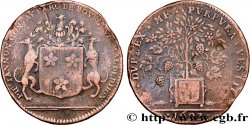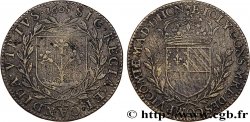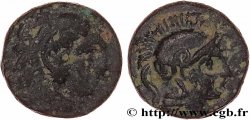fjt_791731 - DIJON (MAYORS OF ... and miscellaneous) Jacques de Frasans 1631
40.00 €(Approx. 41.60$ | 33.20£)
Quantity
Add to your cart

Type : Jacques de Frasans
Date: 1631
Metal : red copper
Diameter : 27 mm
Orientation dies : 6 h.
Weight : 6,18 g.
Edge : lisse
Catalogue references :
Predigree :
Exemplaire provenant de la Collection MARINECHE
Obverse
Obverse legend : FOELIX. RVINA. TANTO. REPARATORE. ; À L’EXERGUE : .1631..
Obverse description : Armes de Jacques Frasans.
Obverse translation : La chute est bienvenue quand vient ensuite un si grand restaurateur.
Reverse
Reverse legend : IACQ. DE. FRASANS. ESC. C. D. ROY. VIC. MAIEUR. D. DIION.
Reverse description : Armes de Dijon.
Commentary
Jacques de Frasans, avocat, fut élu maire pour la huitième fois, le 17 juin 1662. Il meurt en exercice en avril 1663 et est remplacé pour la fin de sa magistrature par son gendre Bénigne Boulier
Les maires de Dijon
Dès l’époque de la naissance de la féodalité, la ville de Dijon possédait un maire et en général vingt magistrats municipaux, ou échevins. Ces magistrats sont confirmés en 1187, lorsqu’une charte de commune est accordée par le duc Hugues III. En 1192, pour la première fois, le maire dijonnais est élu.
A la fin du XIIIe siècle, ce maire prend le titre de vicomte maïeur, confirmé en 1477-1479 par Louis XI, qu’il gardera jusqu’en 1789. Depuis la fin du XVe siècle (1491), la charge de vicomte maïeur est anoblissante ainsi que celle d’échevin à compter du XVIe siècle. Le vicomte maïeur avait le droit de haute, moyenne et basse justice, le droit de scel et de visite. Les clefs de la ville lui sont confiées et il dirige les archers ainsi que les compagnies des sept quartiers, cette fonction militaire étant importante jusqu’au XVIIe siècle.
Fonction élective, le vicomte maïeur est élu par les habitants, ni mendiants, ni étrangers, qui payent la taille, en général la veille de la Saint-Jean. Cette élection a lieu sur le parvis de l'église saint Philibert. A partir de 1669, il est permis au maire de porter "une robe longue de satin plein, de couleur violet, doublée de satin rouge cramoisi, comme le prévôt des marchands de Lyon, avec chaperon de même étoffe et couleur bordée d’hermine" afin de se distinguer des habitants.
En 1692, la fonction de vicomte maïeur est transformée en office héréditaire tandis que l’élection n’est plus alors qu’une confirmation du choix royal fait par le gouverneur au nom du roi.
Voir leur liste complète à http://fr.wikipedia.org/wiki/Liste_des_maires_de_Dijon.
Les maires de Dijon
Dès l’époque de la naissance de la féodalité, la ville de Dijon possédait un maire et en général vingt magistrats municipaux, ou échevins. Ces magistrats sont confirmés en 1187, lorsqu’une charte de commune est accordée par le duc Hugues III. En 1192, pour la première fois, le maire dijonnais est élu.
A la fin du XIIIe siècle, ce maire prend le titre de vicomte maïeur, confirmé en 1477-1479 par Louis XI, qu’il gardera jusqu’en 1789. Depuis la fin du XVe siècle (1491), la charge de vicomte maïeur est anoblissante ainsi que celle d’échevin à compter du XVIe siècle. Le vicomte maïeur avait le droit de haute, moyenne et basse justice, le droit de scel et de visite. Les clefs de la ville lui sont confiées et il dirige les archers ainsi que les compagnies des sept quartiers, cette fonction militaire étant importante jusqu’au XVIIe siècle.
Fonction élective, le vicomte maïeur est élu par les habitants, ni mendiants, ni étrangers, qui payent la taille, en général la veille de la Saint-Jean. Cette élection a lieu sur le parvis de l'église saint Philibert. A partir de 1669, il est permis au maire de porter "une robe longue de satin plein, de couleur violet, doublée de satin rouge cramoisi, comme le prévôt des marchands de Lyon, avec chaperon de même étoffe et couleur bordée d’hermine" afin de se distinguer des habitants.
En 1692, la fonction de vicomte maïeur est transformée en office héréditaire tandis que l’élection n’est plus alors qu’une confirmation du choix royal fait par le gouverneur au nom du roi.
Voir leur liste complète à http://fr.wikipedia.org/wiki/Liste_des_maires_de_Dijon.








 Report a mistake
Report a mistake Print the page
Print the page Share my selection
Share my selection Ask a question
Ask a question Consign / sell
Consign / sell
 Full data
Full data










